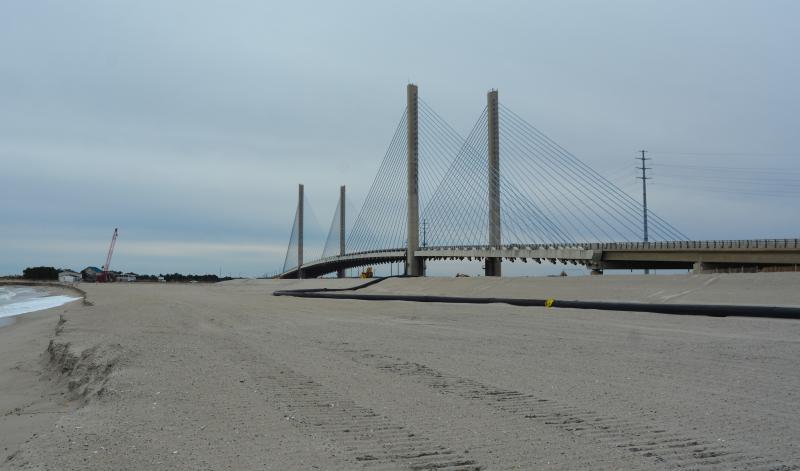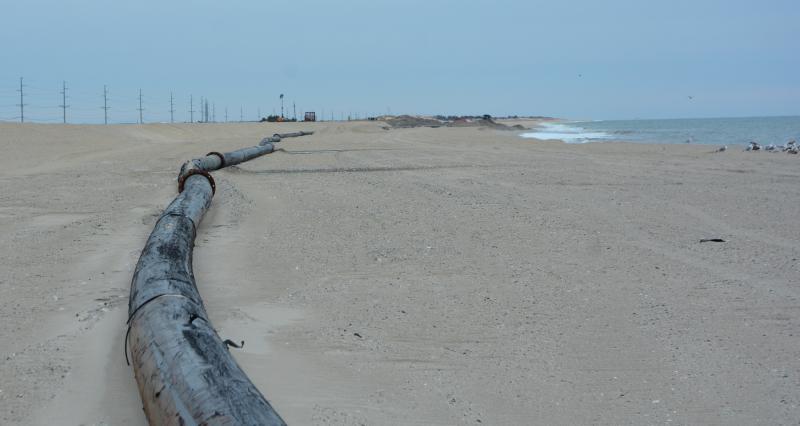DNREC nearing end of inlet’s beach replenishment
After a little more than two months of work, the Delaware Department of Natural Resources and Environmental Control said the first phase of a beach replenishment project immediately north of the Indian River Inlet is nearing completion.
The emergency fortification project, estimated to cost between $25 million and $28 million, started in late November, following the breaching of the dune north of the inlet twice in six months last year. The two-phase project, which is expected to bring up to 800,000 cubic yards of sand to the mile-long stretch of beach, is a collaboration between DNREC and the Army Corps of Engineers. The state is putting $18 million toward the project and overseeing the first phase. The Army Corps is picking up the rest of the tab, and is expected to begin the second phase of the project in late fall. The sand for the project is coming from shoals found in the inlet, in waters immediately west of the Charles W. Cullen Bridge.
According to a DNREC press release Feb. 7, the project has restored the dune to a width of 25 feet at its crest, and the beach is now at least 150 feet wide along more than 5,000 linear feet of shoreline.
DNREC Secretary Gregory Patterson, who was confirmed as secretary Jan. 30, got a firsthand view of the project as part of a new initiative called Field Trip Friday. According to a press release sent out by DNREC, the initiative was launched “to engage colleagues, elected officials and stakeholders, and to see DNREC’s key projects and programs.”
In an interview a few days after his inaugural trip, Patterson said the original plan called for the state to pump 380,000 cubic yards of sand, but it will end up pumping 480,000. The total amount of the project will not change, he said.
The contractor said there was still sand available in the shoal and that it just made sense to get the work done while all the equipment was there, said Patterson. The state was able to find an additional $3 million for the extra sand, he said. The state had originally agreed to put $15 million toward the project.
Typically, when the Army Corps does a replenishment project, it requires the state to match some portion of it, said Patterson. The additional 100,000 cubic yards and money puts the state’s portion well into that range, he said.
The beach and parking lot on the north side of the inlet have been closed for the duration of the replenishment project. There are several weeks of work left, and then there’s cleanup, but they could reopen by mid-March, said Patterson.
The sand bypass system, expected to be up and running by the end of 2024, is still inoperable. It’s frustrating to a lot of people and it needs to be fixed, said Patterson.
The equipment for the sand bypass system is located near the visitor parking lot on the south side of the bridge. The system moves sand from the south side to the north side, but it hasn’t worked since before COVID.
Patterson said there have been supply chain issues, and DNREC is waiting for pumps to be delivered from Europe, which was the only place they could be found. The expectation is that the pumps will arrive in May, with the bypass system working by July, he said.
Patterson said even if the bypass had been fixed, the state wouldn’t be using it this time of year, and then there are time-of-year restrictions in place from April to June, so it wouldn’t be operating much before July. When working, the bypass system can move up to 100,000 cubic yards of sand to the north side annually, which is helpful, but not enough to have prevented a major replenishment project like this, he said.
Chris Flood has been working for the Cape Gazette since early 2014. He currently covers Rehoboth Beach and Henlopen Acres, but has also covered Dewey Beach and the state government. He covers environmental stories, business stories, random stories on subjects he finds interesting and has a column called ‘Choppin’ Wood’ that runs every other week. Additionally, Chris moonlights as the company’s circulation manager, which primarily means fixing boxes during daylight hours that are jammed with coins, but sometimes means delivering papers in the middle of the night. He’s a graduate of the University of Maine and the Landing School of Boat Building & Design.























































